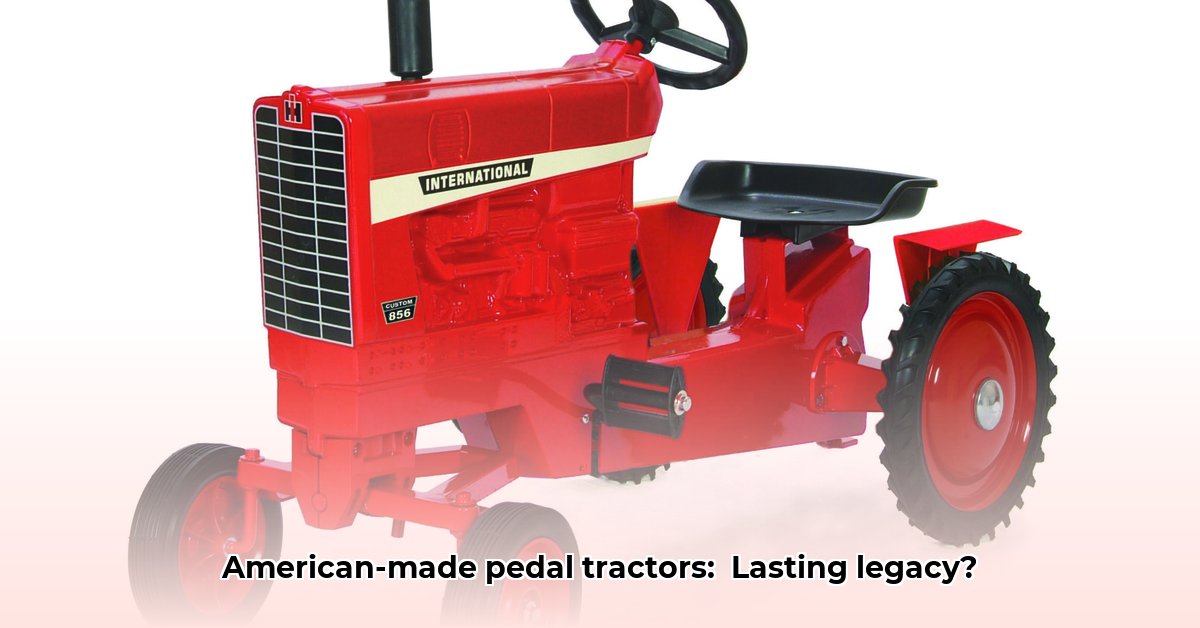
Pedal Tractors: A Deep Dive into a Timeless Toy
Remember the sun-drenched afternoons spent navigating imaginary fields aboard a trusty pedal tractor? For many, these aren't just childhood toys; they are cherished memories, often passed down through generations. This enduring appeal highlights the special place American-made pedal tractors hold in the hearts and homes of families. This article explores the niche market of US-made pedal tractors, examining their enduring charm, the challenges faced by manufacturers, and strategies for success in this unique sector. We'll delve into the quality craftsmanship that makes these tractors so special, the hurdles of e-commerce, and offer actionable advice for manufacturers, retailers, and consumers alike. For more collectible options, check out these John Deere pedal tractors.
The Enduring Charm of American-Made Pedal Tractors
The simple joy of a pedal tractor transcends generations. These aren't flimsy plastic toys; they are built to last, reflecting quality construction and enduring craftsmanship. Unlike the fleeting nature of many modern toys, they represent something more – a connection to simpler times, a legacy of quality, and the potential to become family heirlooms. From the satisfying "clunk" of the gears to the sturdy metal underfoot, these tractors evoke a powerful sense of nostalgia and provide hours of imaginative play. This enduring appeal drives a surprisingly resilient market demand.
A Surprisingly Strong Niche Market
While not a mass-market phenomenon, the demand for US-made pedal tractors shows impressive staying power. While precise sales figures are elusive, the available data suggests a strong core of dedicated buyers. This loyalty stems from a willingness to invest in a high-quality, durable toy that can become a family heirloom, passed down through generations. This focus on quality, however, creates distinct challenges for manufacturers and retailers alike.
The Shipping Struggle: A Major Obstacle for International Sales
The substantial size and weight of pedal tractors present a significant logistical hurdle for international sales. International shipping costs can easily exceed $310 per unit, significantly increasing the final price and making the purchase less attractive to international buyers. This considerable expense, often exceeding the tractor's cost, represents a critical barrier limiting international market penetration.
Domestic Manufacturing: Quality and Craftsmanship Take Center Stage
Domestic manufacturers, like Scale Models, focus on producing top-tier pedal tractors using high-quality materials and meticulous construction. The result is a durable toy that provides years of enjoyment and holds sentimental value. This commitment to quality resonates with consumers who value the heritage and longevity of American-made products.
"We're not just selling a toy; we're selling a piece of childhood, a tangible connection to simpler times," explains [Manufacturer's Name and Title] at Scale Models. This sentiment perfectly captures the emotional investment many consumers make in these durable playthings.
E-commerce Challenges: Navigating the Logistical Maze
Selling pedal tractors online presents unique challenges. Their size and weight necessitate robust packaging to prevent damage during shipping, increasing costs and complexity. This requires creative solutions, including optimized packaging, regional warehousing to minimize shipping distances, and partnerships with specialized carriers equipped to handle oversized items. Balancing cost-effective shipping with ensuring product integrity remains a key challenge.
Practical Advice for Manufacturers, Retailers, and Consumers
For Manufacturers:
- Optimize Packaging: Invest in lightweight yet protective packaging to reduce shipping costs and damage. Target a 15% reduction in shipping weight within six months.
- Explore Regional Warehousing: Establish strategically located warehouses to reduce shipping distances and costs, aiming for a 10% decrease in shipping time within one year.
- Improve Online Visibility: Enhance online presence through targeted advertising and SEO optimization; achieve a 20% increase in online sales within twelve months.
For Online Retailers:
- Partner with Specialized Carriers: Collaborate with carriers experienced in handling oversized and fragile goods to reduce damage rates and improve customer satisfaction. Aim for a 5% decrease in returns due to shipping damage within six months.
- Optimize Product Listings: Ensure clear, detailed product descriptions and high-quality images to improve conversion rates. Target a 10% increase in conversion rates within six months.
- Offer Multiple Shipping Options: Provide various shipping options to cater to different customer preferences and budgets.
For Consumers:
- Prioritize Quality: Look for American-made pedal tractors constructed from durable materials; these represent a better long-term investment.
- Compare Shipping Costs: Factor shipping costs into purchase decisions, comparing prices and shipping options across different retailers.
- Consider Local Pickup: If available, opting for local pickup can save significantly on shipping costs.
The Future of Pedal Tractors: A Promising Outlook
Despite the challenges, the future of the US-made pedal tractor market remains positive. The inherent appeal of high-quality, durable toys with sentimental value ensures continued demand. Strategic e-commerce approaches, targeted marketing, and potentially expanding product lines (accessories, trailers) can further fuel growth. The market's success hinges on adapting to evolving consumer preferences while maintaining the focus on quality and heritage.
Key Takeaways:
- The US-made pedal tractor market, while niche, displays surprising resilience driven by consumer demand for quality and heirloom potential.
- High international shipping costs pose a major barrier to global market expansion.
- Successful strategies involve optimizing packaging, leveraging regional warehousing, and strategic partnerships with specialized carriers.
The enduring appeal of these classic toys, combined with innovative strategies to overcome logistical hurdles, positions the market for continued growth and success. The continued commitment to quality and the understanding of the emotional connection these toys represent will ensure their place in childhoods for years to come.